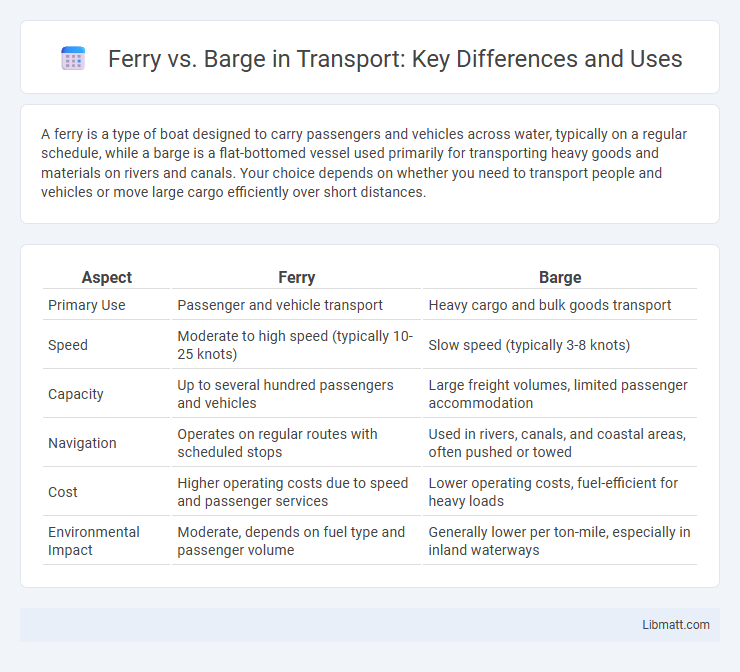A ferry is a type of boat designed to carry passengers and vehicles across water, typically on a regular schedule, while a barge is a flat-bottomed vessel used primarily for transporting heavy goods and materials on rivers and canals. Your choice depends on whether you need to transport people and vehicles or move large cargo efficiently over short distances.
Table of Comparison
| Aspect | Ferry | Barge |
|---|---|---|
| Primary Use | Passenger and vehicle transport | Heavy cargo and bulk goods transport |
| Speed | Moderate to high speed (typically 10-25 knots) | Slow speed (typically 3-8 knots) |
| Capacity | Up to several hundred passengers and vehicles | Large freight volumes, limited passenger accommodation |
| Navigation | Operates on regular routes with scheduled stops | Used in rivers, canals, and coastal areas, often pushed or towed |
| Cost | Higher operating costs due to speed and passenger services | Lower operating costs, fuel-efficient for heavy loads |
| Environmental Impact | Moderate, depends on fuel type and passenger volume | Generally lower per ton-mile, especially in inland waterways |
Introduction to Ferries and Barges
Ferries and barges serve distinct roles in maritime transportation, with ferries primarily designed to carry passengers and vehicles across bodies of water on scheduled routes. Barges are flat-bottomed vessels mainly used for transporting bulk goods and heavy cargo in inland waterways or ports, often requiring tugboats for movement. Both types of vessels contribute significantly to global logistics, enabling efficient transport in areas where bridges or tunnels are impractical.
Core Differences Between Ferries and Barges
Ferries are passenger vessels designed to transport people, vehicles, and cargo across bodies of water on scheduled routes, often equipped with amenities for comfort and safety. Barges are flat-bottomed vessels primarily used for transporting heavy or bulk goods, typically towed or pushed by tugboats rather than self-propelled. The core differences lie in purpose, design, and propulsion, with ferries emphasizing passenger transport and barges focusing on freight movement.
Types and Purposes of Ferries
Ferries come in various types, including passenger ferries, vehicle ferries, and double-ended ferries, each designed to serve specific transportation needs. Passenger ferries primarily transport people across bodies of water, while vehicle ferries carry cars, trucks, and sometimes heavy machinery, facilitating efficient travel where bridges are unavailable. Understanding these types helps optimize your travel plans by selecting the appropriate ferry based on cargo and passenger requirements.
Types and Functions of Barges
Barges come in various types including flat-bottomed, tank, hopper, and crane barges, each designed for specific functions such as transporting bulk cargo, liquid materials, or heavy equipment. Unlike ferries, which primarily carry passengers and vehicles across water, barges are focused on cargo transport and are often used in ports, rivers, and canals for efficient logistics. Understanding the type of barge suitable for your shipment ensures optimal handling and cost-effective transportation.
Passenger Transport: Ferries vs Barges
Ferries are specifically designed for passenger transport, often equipped with seating, restrooms, and safety features to accommodate comfort and security over short to medium distances. Barges primarily serve cargo transport with minimal passenger facilities, making them less suitable and less common for carrying passengers. In terms of passenger transport efficiency, ferries provide faster and safer transit compared to barges, which are slower and optimized for bulk goods movement.
Cargo Handling: Barges vs Ferries
Barges excel in cargo handling by transporting heavy, bulk goods such as raw materials, construction equipment, and large containers, making them ideal for industrial and commercial shipping along rivers and canals. Ferries, on the other hand, primarily focus on carrying passengers and vehicles, offering efficient loading and unloading mechanisms suited for cars, trucks, and foot traffic. Your choice between a barge and ferry should depend on the nature of cargo and the specific logistical requirements of your transportation needs.
Design and Structure Comparison
Ferries feature streamlined hulls and passenger-friendly decks designed for comfortable transport across shorter distances, often equipped with multiple levels to accommodate vehicles and passengers. Barges prioritize flat, sturdy platforms with minimal superstructures, optimized for carrying heavy cargo or bulk materials over rivers and canals. Your choice depends on whether you need passenger amenities or maximum cargo capacity in the vessel's design and structure.
Operational Routes and Accessibility
Ferries operate on fixed, frequent schedules connecting established routes, primarily across short distances like rivers, bays, and coastal waters, facilitating regular passenger and vehicle transport. Barges navigate a wider variety of waterways, including rivers, canals, and coastal areas, often transporting heavy cargo with flexible routing based on industrial demand rather than strict schedules. Ferry terminals are designed for rapid boarding and disembarking, improving accessibility for public use, while barges typically require specialized loading facilities tailored for bulk goods and heavy equipment.
Cost and Efficiency Considerations
Ferries typically incur higher operational costs due to faster speeds and passenger amenities, while barges offer greater fuel efficiency for transporting heavy cargo over short to medium distances. Barges maximize cargo capacity with lower fuel consumption per ton, making them cost-effective for bulk freight, whereas ferries optimize passenger and vehicle transport with quicker turnaround times. Your choice depends on balancing upfront expenses against operational efficiency for the specific transport needs.
Environmental Impact and Sustainability
Ferries often have a smaller environmental footprint than barges due to their advanced fuel efficiency and regular incorporation of cleaner energy technologies like electric or hybrid propulsion systems. Barges, while capable of transporting larger loads, typically rely on diesel engines that produce higher carbon emissions and contribute to water pollution. Your choice between ferry and barge can significantly influence sustainability efforts, especially when prioritizing reduced greenhouse gas emissions and minimizing aquatic ecosystem disruption.
ferry vs barge Infographic

 libmatt.com
libmatt.com